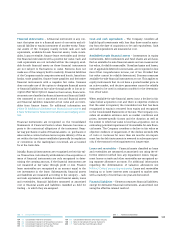Siemens 2011 Annual Report Download - page 269
Download and view the complete annual report
Please find page 269 of the 2011 Siemens annual report below. You can navigate through the pages in the report by either clicking on the pages listed below, or by using the keyword search tool below to find specific information within the annual report.
153 D. Consolidated Financial Statements 273 E. Additional information
158 D. Consolidated Statements of Changes in Equity
160 D. Notes to Consolidated Financial Statements
266 D. Supervisory Board and Managing Board
154 D. Consolidated Statements of Income
155 D. Consolidated Statements of Comprehensive Income
156 D. Consolidated Statements of Financial Position
157 D. Consolidated Statements of Cash Flow
Financial instruments – A financial instrument is any con-
tract that gives rise to a financial asset of one entity and a fi-
nancial liability or equity instrument of another entity. Finan-
cial assets of the Company mainly include cash and cash
equivalents, available-for-sale financial assets, trade receiv-
ables, loans receivable, finance lease receivables and deriva-
tive financial instruments with a positive fair value. Cash and
cash equivalents are not included within the category avail-
able-for-sale financial assets as these financial instruments
are not subject to fluctuations in value. Siemens does not
make use of the category held to maturity. Financial liabilities
of the Company mainly comprise notes and bonds, loans from
banks, trade payables, finance lease payables and derivative
financial instruments with a negative fair value. Siemens
does not make use of the option to designate financial assets
or financial liabilities at fair value through profit or loss at in-
ception (Fair Value Option).
Based on their nature, financial in-
struments are classified as financial assets and financial liabili-
ties measured at cost or amortized cost and financial assets
and financial liabilities measured at fair value and as receiv-
ables from finance leases. For additional information see
Note
31 Additional disclosures on financial instruments and
Note
32 Derivative financial instruments and hedging activi-
ties.
Financial instruments are recognized on the Consolidated
Statements of Financial Position when Siemens becomes a
party to the contractual obligations of the instrument. Regu-
lar way purchases or sales of financial assets, i.e. purchases or
sales under a contract whose terms require delivery of the as-
set within the time frame established generally by regulation
or convention in the marketplace concerned, are accounted
for at the trade date.
Initially, financial instruments are recognized at their fair val-
ue. Transaction costs directly attributable to the acquisition or
issue of financial instruments are only recognized in deter-
mining the carrying amount, if the financial instruments are
not measured at fair value through profit or loss. Finance
lease receivables are recognized at an amount equal to the
net investment in the lease. Subsequently, financial assets
and liabilities are measured according to the category – cash
and cash equivalents, available-for-sale financial assets, loans
and receivables, financial liabilities measured at amortized
cost or financial assets and liabilities classified as held for
trading – to which they are assigned.
Cash and cash equivalents – The Company considers all
highly liquid investments with less than three months matu-
rity from the date of acquisition to be cash equivalents. Cash
and cash equivalents are measured at cost.
Available-for-sale financial assets – Investments in equity
instruments, debt instruments and fund shares are all classi-
fied as available-for-sale financial assets and are measured at
fair value, if reliably measurable. Unrealized gains and losses,
net of applicable deferred income taxes, are recognized in line
item Other comprehensive income, net of tax. Provided that
fair value cannot be reliably determined, Siemens measures
available-for-sale financial instruments at cost. This applies to
equity instruments that do not have a quoted market price in
an active market, and decisive parameters cannot be reliably
estimated to be used in valuation models for the determina-
tion of fair value.
When available-for-sale financial assets incur a decline in fair
value below acquisition cost and there is objective evidence
that the asset is impaired, the cumulative loss that has been
recognized in equity is removed from equity and recognized
in the Consolidated Statements of Income. The Company con-
siders all available evidence such as market conditions and
prices, investee-specific factors and the duration as well as
the extent to which fair value is less than acquisition cost in
evaluating potential impairment of its available-for-sale finan-
cial assets. The Company considers a decline in fair value as
objective evidence of impairment, if the decline exceeds %
of costs or continues for more than six months. An impair-
ment loss for debt instruments is reversed in subsequent peri-
ods, if the reasons for the impairment no longer exist.
Loans and receivables – Financial assets classified as loans
and receivables are measured at amortized cost using the ef-
fective interest method less any impairment losses. Impair-
ment losses on trade and other receivables are recognized us-
ing separate allowance accounts. For additional information
regarding the determination of valuation allowances see
Note
3 Critical accounting estimates. Loans and receivables
bearing no or lower interest rates compared to market rates
with a maturity of more than one year are discounted.
Financial liabilities – Siemens measures financial liabilities,
except for derivative financial instruments, at amortized cost
using the effective interest method.
























